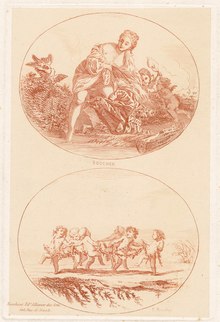Chine-collé
Chine-collé or chine collé (French: [ʃin.kɔ.le]) is a printmaking technique in which the image is transferred onto a surface that is bonded onto a heavier support in the printing process.
One purpose is to allow the printmaker to print on a much more delicate surface, such as Japanese paper or linen, that pulls finer details off the plate.
The word chine is used because the thin paper traditionally used in the process was imported to Europe from China, India and/or Japan.
Then, the ensemble (plate plus thin paper with paste) is placed on a dampened backing sheet and run through a press as described above.
An advantage of the pre-pasted method is that once dried, the paste-applied papers can be stored indefinitely, just like a lick-and-stick postage stamp.
For example, some experiment with pre-cut shapes for a collage effect, or simultaneously adhere multiple overlapping pieces of paper under the printed image.
Some artists experiment with non-traditional papers, using such things as newspaper, ephemera, dress patterns, and book pages as the sheet to be printed on.


